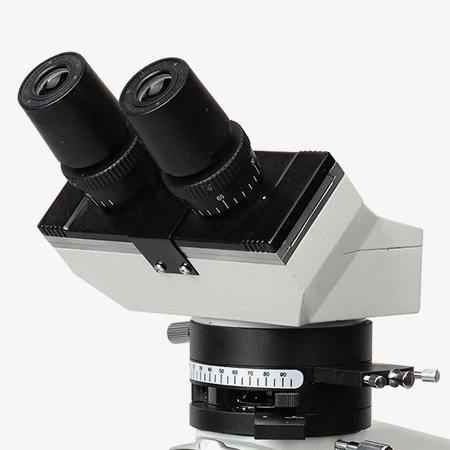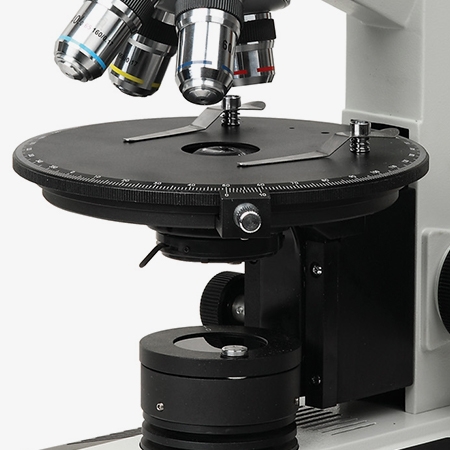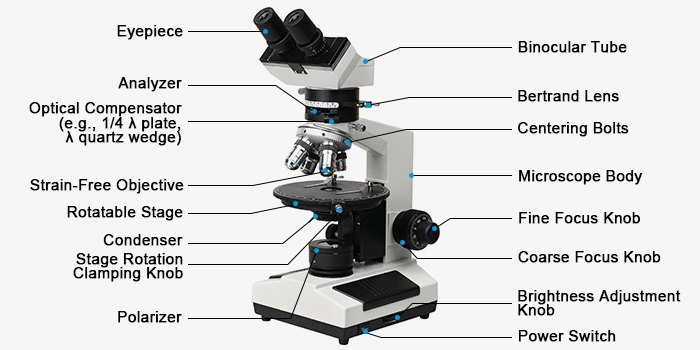A polarizing microscope is a type of optical microscope that uses polarized light to observe materials with anisotropic properties. It is widely used in geology, mineralogy, materials science, and biology to examine internal structures, stress distribution, or birefringence in samples such as crystals, minerals, fibers, and polymers. This microscope for mineralogy provides accurate and high-contrast imaging essential for professional and research-grade analysis.

Ergonomic Binocular Viewing System
- Sliding Binocular Head: This polarized light microscope features a 45° inclined design with diopter adjustment, offering a balance of comfort and ease of operation for extended use.
- Widefield Plan Eyepiece WF10X/18mm: The microscope provides a broad, flat field of view with reduced edge distortion, improving observational efficiency and image clarity, essential for polarized light microscopy.

Advanced Optical & Illumination System
- Strain-Free Achromatic Objectives (4X/10X/40X): The lab microscope is designed to minimize optical aberrations and internal stress, delivering sharp, color-corrected images ideal for examining birefringent materials.
- Adjustable Halogen Illumination (6V/20W): The built-in, continuously adjustable halogen lamp of the polarizing microscope provides even lighting.

Precision Stage and Anti-Vibration Structure
- Circular Rotating Stage (Ø160mm): Marked in 1° increments with a minimum resolution of 6′, this binocular polarizing microscope allows accurate positioning and quick switching between multiple samples, perfect for polarized crystal analysis.
- High-Rigidity Frame Design: A compact and robust structure minimizes vibration from external sources, providing stable imaging performance even in demanding laboratory environments.
Applications
In electronics manufacturing, SISCO's microscopes assist engineers in inspecting tiny circuit components for precise soldering and assembly. In watch repair, technicians use microscopes to examine intricate parts for accurate restoration and repair. During chemical experiments, researchers observe microscopic reactions and cellular structures. In gem appraisal, experts rely on microscopes to identify internal features and flaws, determining the gemstone’s quality and authenticity.

Watch Repair

Chemical Experiments

Gem Appraisal

Electronics Manufacturing
| Model | SISCO-AM-MSC-P107B | ||||
| Viewing Head | Sliding binocular head, inclined at 45°, 360° rotatable | ||||
| Eyepiece | WF10X/18mm with crosshair scale | ||||
| Mechanical Tube Length | 160mm | ||||
| Objective | Strain-free achromatic objectives: 4X/10X/40X | ||||
| Objective Conjugate Distance | 195mm | ||||
| Nosepiece | Center-adjustable quadruple nosepiece | ||||
| Assistant Lens | 1X auxiliary lens | ||||
| Analyzer | 0°~90° rotatable, swing-out analyzer with gradation | ||||
| Polarizer | 0°, slide-in/out of the optical path, positioned above the collector | ||||
| Bertrand Lens | Swing-in/out capability for conoscopic observation | ||||
| Optical Compensator | Includes 1/4λ slip, λ slip, and quartz wedge; insertable at 45° | ||||
| Rotating Stage | Circular stage, Ø160mm, 360° rotatable, 1° increments, min. resolution 6′ | ||||
| Condenser | NA 1.25 Abbe condenser with iris diaphragm and filter | ||||
| Focusing System | Coaxial coarse & fine adjustment (rack and pinion), focus range 28mm | ||||
| Fine Focus Sensitivity | Fine division: 0.002mm | ||||
| Illumination | 6V/20W halogen lamp, brightness adjustable | ||||
| Power Supply | AC 220V / 110V ±10%, 50/60Hz | ||||
| Dimensions (W×D×H) | 327×273×425 (mm) | ||||
| Weight | 8kg | ||||
| Stain-free Achromatic Objectives | |||||
| Magnification | Numerical Value (NA) | Thickness of Cover Slip (mm) | Focus (mm) | Work Distance (mm) | Work Type |
| 4X | 0.1 | 0.17 | 31.05 | 37.5 | Dry |
| 10X | 0.25 | 0.17 | 17.13 | 7.316 | Dry |
| 40X | 0.65 | 0.17 | 4.65 | 0.632 | Dry |
| 60X (Optional) | 0.85 | 0.17 | 2.969 | 0.185 | Dry |
| Crosshair Scale Ocular | |||||
| Kind | Magification | Focus (mm) | Linear Field of View (mm) | ||
| Plan Lens | 10X | 24.95 | Ø18 | ||
| Sum Magnification | |||||
| Ocular | 10X | 10X | 10X | 10X | |
| Objective | 4X | 10X | 40X | 60X | |
| Total | 40X | 100X | 400X | 600X | |
Structures

Q1: What materials can be observed with this polarizing microscope?
A1: This polarizing microscope is ideal for examining anisotropic materials such as crystals, minerals, polymers, fibers, and biological tissues. It’s widely used in geology, mineralogy, materials science, and biology to analyze optical properties like birefringence, internal stress distribution, and crystal orientation.
Q2: Can I perform quantitative analysis using this polarized light microscope?
A2: Yes. The microscope includes a rotatable analyzer (0°–90°), optical compensators (1/4λ, λ, quartz wedge), and a vernier-scale rotating stage (1° gradation, 6' resolution), enabling precise measurements of birefringence and optical retardation. These features support both qualitative and semi-quantitative analysis in scientific and academic research.
Q3: Is the microscope suitable for long-term observation?
A3: Absolutely. With a 45° inclined ergonomic binocular head, widefield 10X eyepieces, and a coaxial coarse/fine focus system, the microscope is comfortable for extended use. The high-rigidity frame reduces vibration, while the smooth mechanical stage and low-position adjustment knobs help minimize fatigue during prolonged sessions.
Tips: How can you enhance image clarity and contrast in polarized light observations?
To improve image clarity and contrast during polarization observations, always start by centering the condenser and aligning the optical path using the Bertrand lens. For best results, adjust the polarizer and analyzer angles to fully cross the polarizing light – this maximizes birefringence visibility and enhances detail resolution in your samples.
Thank you for buying industrial test and measurement equipment on SISCO.com, all products sold by SISCO and the partner cover a 12 months warranty, effective from the date of receiving the products.
What is covered?
SISCO is responsible for providing free spare parts, and free technical support to assist the customer to repair the defective products until the problem is solved.
What is not covered?
- Product purchased from anyone other than a SISCO store or a SISCO authorized reseller.
- Expendable parts.
- Routine cleaning or normal cosmetic and mechanical wear.
- Damage from misuse, abuse or neglect.
- Damage from use of parts other than SISCO approved.
- Damage from use outside the product’s usage or storage parameters.
- Damage from use of parts not sold by SISCO.
- Damage from modification or incorporation into other products.
- Damage from repair or replacement of warranted parts by a service provider other than a SISCO authorized service provider.
- Damage caused by the application environment not meeting the product usage requirements and the failure to perform preventive maintenance.

